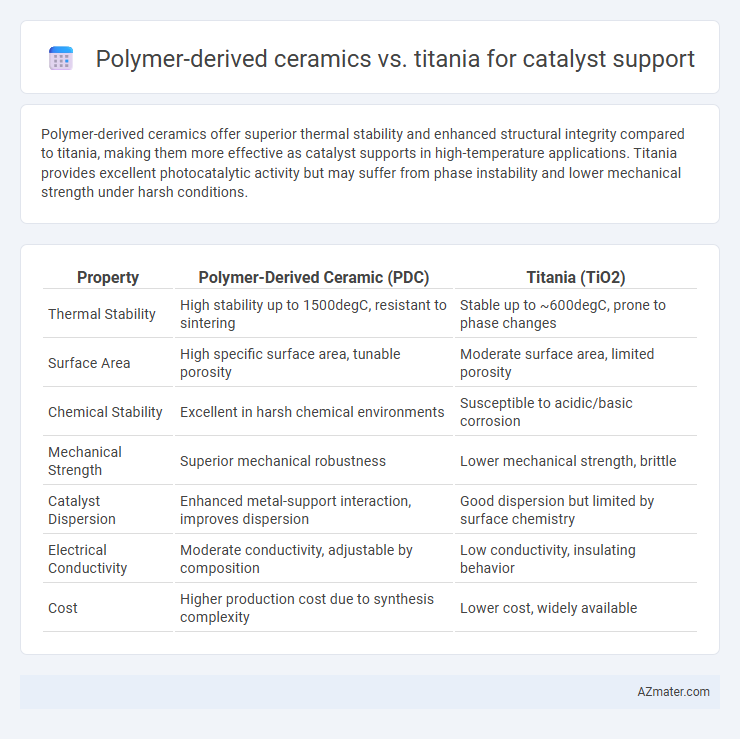Polymer-derived ceramics offer superior thermal stability and enhanced structural integrity compared to titania, making them more effective as catalyst supports in high-temperature applications. Titania provides excellent photocatalytic activity but may suffer from phase instability and lower mechanical strength under harsh conditions.
Table of Comparison
| Property | Polymer-Derived Ceramic (PDC) | Titania (TiO2) |
|---|---|---|
| Thermal Stability | High stability up to 1500degC, resistant to sintering | Stable up to ~600degC, prone to phase changes |
| Surface Area | High specific surface area, tunable porosity | Moderate surface area, limited porosity |
| Chemical Stability | Excellent in harsh chemical environments | Susceptible to acidic/basic corrosion |
| Mechanical Strength | Superior mechanical robustness | Lower mechanical strength, brittle |
| Catalyst Dispersion | Enhanced metal-support interaction, improves dispersion | Good dispersion but limited by surface chemistry |
| Electrical Conductivity | Moderate conductivity, adjustable by composition | Low conductivity, insulating behavior |
| Cost | Higher production cost due to synthesis complexity | Lower cost, widely available |
Introduction to Catalyst Supports
Catalyst supports influence the dispersion, stability, and activity of active catalytic sites, making material choice critical. Polymer-derived ceramics (PDCs) offer exceptional thermal stability, tunable porosity, and high surface areas compared to traditional titania (TiO2) supports. Titania remains widely used due to its photocatalytic properties and strong metal-support interactions but can suffer from phase transformations and limited thermal robustness under harsh reaction conditions.
Overview of Polymer-Derived Ceramics (PDCs)
Polymer-derived ceramics (PDCs) are advanced materials synthesized through the pyrolysis of preceramic polymers, resulting in amorphous, nanostructured ceramics with exceptional thermal stability and chemical resistance. Their tunable porosity and high surface area make PDCs ideal catalyst supports, enhancing metal dispersion and catalytic activity compared to conventional supports like titania. The flexibility in composition and morphology of PDCs allows for tailored interactions with catalytic species, promoting improved durability and performance under harsh reaction conditions.
Properties of Titania as a Catalyst Support
Titania, or titanium dioxide (TiO2), exhibits high thermal stability and strong metal-support interactions, which enhance catalyst dispersion and prevent sintering during reactions. Its acidic and redox properties facilitate enhanced catalytic activity for oxidation reactions, making it ideal for supporting noble metals in selective oxidation or photocatalytic processes. Furthermore, the high surface area and tunable crystalline phases (anatase, rutile) of titania contribute to improved catalytic performance and durability under harsh reaction conditions.
Structural Differences Between PDCs and Titania
Polymer-derived ceramics (PDCs) exhibit an amorphous or nanocrystalline structure with high thermal stability and tunable porosity, whereas titania (TiO2) typically possesses a well-defined crystalline anatase or rutile phase. PDCs offer superior resistance to sintering and phase transformation under harsh catalytic conditions compared to titania, which can suffer from phase changes that affect catalytic performance. The inherent structural durability and tailored microstructure of PDCs make them advantageous for maintaining active sites and enhancing catalyst lifespan over titania supports.
Thermal Stability Comparison
Polymer-derived ceramics (PDCs) exhibit superior thermal stability compared to titania due to their robust amorphous or nanocrystalline structure that resists sintering and phase transformation at temperatures above 1000degC. Titania, while widely used, undergoes phase transitions such as anatase to rutile around 600-700degC, leading to structural degradation and reduced catalytic performance. The high thermal stability of PDCs supports enhanced durability and functionality in high-temperature catalytic applications, making them preferable in harsh operational environments.
Surface Area and Porosity Analysis
Polymer-derived ceramics exhibit higher specific surface areas and tunable porosity compared to titania, enhancing their catalytic support efficiency by providing more active sites and improved reactant diffusion. Titania typically presents lower surface area and limited pore volume, which can restrict catalyst dispersion and accessibility. Advanced surface area and porosity analysis using BET and BJH methods confirms that polymer-derived ceramics achieve mesoporous structures with increased pore connectivity vital for optimizing catalytic performance.
Chemical Compatibility and Resistance
Polymer-derived ceramics exhibit superior chemical compatibility and resistance compared to titania when used as catalyst supports in harsh reaction environments. Their amorphous or nanocrystalline structure provides enhanced resistance to strong acids, bases, and high temperatures, preventing degradation and maintaining catalyst integrity. Titania, while possessing good mechanical strength and surface area, is more prone to phase transformation and chemical corrosion under extreme pH or oxidative conditions, limiting its long-term stability.
Influence on Catalyst Dispersion and Activity
Polymer-derived ceramics (PDCs) exhibit superior thermal stability and a highly tunable porous structure, which enhances catalyst dispersion more effectively than titania supports. Titania offers strong metal-support interactions beneficial for specific catalytic reactions but may suffer from lower surface area and sintering at high temperatures, limiting catalyst dispersion and activity. PDCs maintain higher catalytic activity due to their resistance to sintering and tailored surface chemistry, promoting uniform metal nanoparticle distribution and sustained active site availability.
Industrial Applications and Case Studies
Polymer-derived ceramics (PDCs) offer superior thermal stability, tunable porosity, and excellent mechanical strength, making them highly effective catalyst supports in high-temperature industrial processes such as hydrocarbon cracking and biomass pyrolysis. In contrast, titania supports are widely favored for their strong metal-support interactions and photocatalytic properties, particularly in automotive exhaust treatment and selective oxidation reactions. Case studies demonstrate that PDC-based catalysts enhance durability and maintain activity under harsh conditions, while titania-supported catalysts excel in applications requiring enhanced photocatalytic efficiency and oxygen storage capacity.
Future Prospects and Research Directions
Polymer-derived ceramics offer exceptional thermal stability, tunable porosity, and superior mechanical strength, making them promising candidates for next-generation catalyst supports compared to conventional titania. Future research is expected to focus on enhancing the surface functionalization of polymer-derived ceramics to improve metal dispersion and catalytic activity. Advanced synthesis techniques and in-situ characterization methods will play a crucial role in optimizing these materials for applications in energy conversion, environmental catalysis, and sustainable chemical manufacturing.

Infographic: Polymer-derived ceramic vs Titania for Catalyst support
 azmater.com
azmater.com